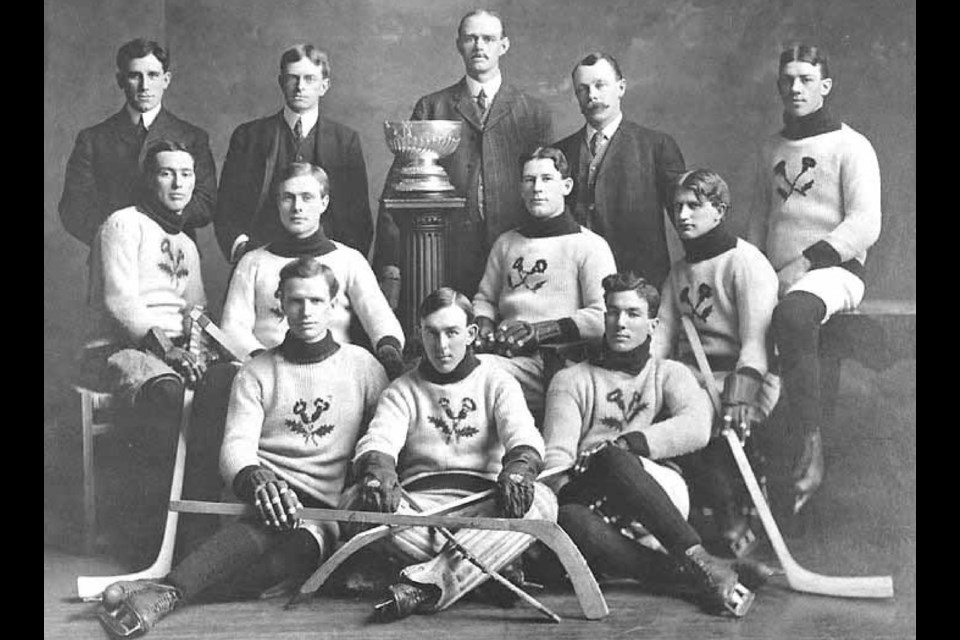Hey, hockey fans. I have a question for you. To the best of your knowledge, are there any hockey players from Stanley Cup-winning teams resting in a Barrie cemetery?
There is at least one, I have found, but I have not been able to establish if there are any others. Let me tell you a little about one outstanding hockey player who took a long and winding route to our town.
Rocque ‘Roxy’ Francis Beaudro was born at Red Lake Falls, Minn., a long way from Barrie, in 1884. Red Lake Falls is some 200 kilometres south of the border with Manitoba.
Minnesota seems like an odd place to find French-Canadians, but this was not the case. To understand why, we have to look back to the late 1700s, when this part of America was a bit of a no-man’s land. Red Lake Falls is located in what was once a rather isolated place, loved only by fur traders and Native Americans.
In 1812, the area was taken over by British Canada. Technically, it was returned to America three years later, but its remote and harsh landscape made it unpopular with would-be settlers.
All of that changed largely due to the work of legendary frontiersman Pierre Bottineau. Bottineau was the son of a French-Canadian man and his Indigenous wife. The jobs and exploits of Bottineau are many and included guiding explorers, translating Native languages, establishing towns and churches, and escorting settlers through the wilderness.
Among the pioneering French-Canadians to settle in Red Lake Falls were the Beaudros from Sorel, Que. Roxy was born to Joseph Henry Beaudreau/Beaudro and Sarah Leger.
Roxy’s father began as a farmer and later took up the brick-making trade. In the late 1880s, he was ready for a complete change and moved his family to Rat Portage, Ont., where he became a hotel keeper.
Rat Portage, near the Manitoba-Ontario border, was renamed Kenora in 1905. When the Beaudros arrived, Rat Portage was a booming town. A sawmill and dozens of gold mines had opened up, and the railway was providing transcontinental travel through the region.
The Beaudros’ Central House hotel, located across the street from the railway station, must have been highly successful. The census of 1901 listed the occupants for that year, which included the 10-member Beaudro family, six servants and 33 hotel guests.
By that time, young Roxy Beaudro was already a keen participant in that favourite pastime in cold-weather provinces and states — ice hockey. He helped his father run the hotel but laced up his skates whenever he had any free time.
Roxy Beaudro was not yet 12 years old when he and his hockey-mad pals challenged the Rat Portage senior hockey team, the Thistles, to a match — and won. When asked later about the loss, a member of the Thistles simply said, “They were too fast for us.” There was no looking back after that.
As the members of the senior team moved on to other things, young Roxy and his comrades stepped into the vacancies and the team became a powerful force. After handily beating everyone in their intermediate league, the Thistles applied to join the Manitoba Hockey League, which was the only more advanced league in the region. The Manitoba Hockey Association was reluctant to allow them in, pointing to the great physical distances between the teams.
In the 1902-03 season, there were only three teams in their league, which included the Thistles and two Winnipeg teams. The Thistles won the championship that year, which entitled them to challenge other Canadian amateur teams for the Stanley Cup.
The National Hockey League did not yet exist in 1903. From 1893, Lord Stanley’s Cup had been awarded yearly to the best amateur team from the various hockey leagues throughout the nation.
During this era, ice hockey really took off and largely departed from its frozen-pond roots. The sport rapidly became a big draw for spectators who were willing to pay to see their favourite players tear up the ice.
In 1900, Barrie and four other neighbouring towns formed the Northern Hockey Association. Competition was fierce and ticket sales were always brisk.
1903 saw the Barrie Colts arrive on the scene and, in 1905, the Colts joined the Ontario Hockey Association.
Meanwhile, in far-off northwestern Ontario, the Rat Portage Thistles, as local league champions, were allowed to make a run for the coveted Cup in March 1903. They were not victorious that year, nor on their next attempt in 1905.
However, 1907 was something entirely different.
Each week, the Barrie Historical Archive provides BarrieToday



